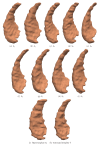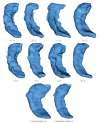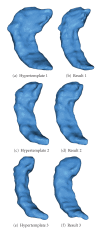A bayesian generative model for surface template estimation
- PMID: 20885934
- PMCID: PMC2946602
- DOI: 10.1155/2010/974957
A bayesian generative model for surface template estimation
Abstract
3D surfaces are important geometric models for many objects of interest in image analysis and Computational Anatomy. In this paper, we describe a Bayesian inference scheme for estimating a template surface from a set of observed surface data. In order to achieve this, we use the geodesic shooting approach to construct a statistical model for the generation and the observations of random surfaces. We develop a mode approximation EM algorithm to infer the maximum a posteriori estimation of initial momentum μ, which determines the template surface. Experimental results of caudate, thalamus, and hippocampus data are presented.
Figures






Similar articles
-
Bayesian template estimation in computational anatomy.Neuroimage. 2008 Aug 1;42(1):252-61. doi: 10.1016/j.neuroimage.2008.03.056. Epub 2008 Apr 11. Neuroimage. 2008. PMID: 18514544 Free PMC article.
-
Bayesian principal geodesic analysis for estimating intrinsic diffeomorphic image variability.Med Image Anal. 2015 Oct;25(1):37-44. doi: 10.1016/j.media.2015.04.009. Epub 2015 Apr 17. Med Image Anal. 2015. PMID: 26159890
-
Statistics on diffeomorphisms via tangent space representations.Neuroimage. 2004;23 Suppl 1:S161-9. doi: 10.1016/j.neuroimage.2004.07.023. Neuroimage. 2004. PMID: 15501085
-
Precise periodic components estimation for chronobiological signals through Bayesian Inference with sparsity enforcing prior.EURASIP J Bioinform Syst Biol. 2016 Jan 20;2016(1):3. doi: 10.1186/s13637-015-0033-6. eCollection 2016 Dec. EURASIP J Bioinform Syst Biol. 2016. PMID: 26834783 Free PMC article.
-
Locally Linear Diffeomorphic Metric Embedding (LLDME) for surface-based anatomical shape modeling.Neuroimage. 2011 May 1;56(1):149-61. doi: 10.1016/j.neuroimage.2011.01.069. Epub 2011 Jan 31. Neuroimage. 2011. PMID: 21281721
Cited by
-
Mechanistic Modeling of Longitudinal Shape Changes: Equations of Motion and Inverse Problems.SIAM J Appl Dyn Syst. 2022;21(1):80-101. doi: 10.1137/21m1423099. SIAM J Appl Dyn Syst. 2022. PMID: 38606305 Free PMC article.
-
Diffeomorphic Surface Registration with Atrophy Constraints.SIAM J Imaging Sci. 2016;9(3):975-1003. doi: 10.1137/15m104431x. Epub 2016 Jul 13. SIAM J Imaging Sci. 2016. PMID: 35646228 Free PMC article.
-
Landmark-free morphometric analysis of knee osteoarthritis using joint statistical models of bone shape and articular space variability.J Med Imaging (Bellingham). 2021 Jul;8(4):044001. doi: 10.1117/1.JMI.8.4.044001. Epub 2021 Jul 5. J Med Imaging (Bellingham). 2021. PMID: 34250198 Free PMC article.
-
A 7 Tesla Amygdalar-Hippocampal Shape Analysis of Lithium Response in Bipolar Disorder.Front Psychiatry. 2021 Feb 16;12:614010. doi: 10.3389/fpsyt.2021.614010. eCollection 2021. Front Psychiatry. 2021. PMID: 33664682 Free PMC article.
-
Amygdalar and Hippocampal Morphometry Abnormalities in First-Episode Schizophrenia Using Deformation-Based Shape Analysis.Front Psychiatry. 2020 Jul 17;11:677. doi: 10.3389/fpsyt.2020.00677. eCollection 2020. Front Psychiatry. 2020. PMID: 32765318 Free PMC article.
References
-
- Durrleman S, Pennec X, Trouvé A, Ayache N. A forward modelto build unbiased atlases from curves and surfaces. In: Proceedings of the International Workshop on the Mathematical Foundations of Computational Anatomy (MFCA ’08); September 2008; New York, NY, USA.
-
- Guimond A, Meunier J, Thirion J-P. Average brain models: a convergence study. Computer Vision and Image Understanding. 2000;77(2):192–210.
-
- Mio W, Srivastava A, Joshi S. On shape of plane elastic curves. International Journal of Computer Vision. 2007;73(3):307–324.
-
- Fletcher PT, Joshi S, Lu C, Pizer SM. Principal geodesic analysis for the study of nonlinear statistics of shape. IEEE Transactions on Medical Imaging. 2004;23(8):995–1005. - PubMed
Grants and funding
LinkOut - more resources
Full Text Sources
Other Literature Sources
Research Materials


